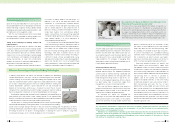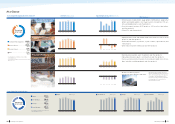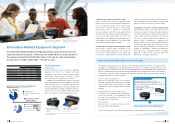Epson 2008 Annual Report Download - page 19
Download and view the complete annual report
Please find page 19 of the 2008 Epson annual report below. You can navigate through the pages in the report by either clicking on the pages listed below, or by using the keyword search tool below to find specific information within the annual report.
34 Seiko Epson Corporation
35Annual Report 2008
Epsons Core Technologies and
Medium-Term R&D Policies
Looking to open the way forward through the power of
technology, Epsons spirit of creativity and challenge
has generated numerous world firsts, including mini-
printers and quartz watches. In the course of
commercializing these products, Epson has
accumulated core ultra-fine processing and energy-
saving technologies that are based on its proprietary
precision and low-power consumption component
technologies, and which sustain Epson to this day.
Based on these, Epson has gone on to develop core
imaging technologies as it has rolled out its inkjet printer,
3LCD projector, display and semiconductor businesses.
As its medium-term R&D policy, Epson intends to
further revolutionize these three core technologies,
which enable compact, energy-saving products that
generate beautiful images, with the goals of improving
customer convenience and realizing customer
aspirations. To turn these goals into reality, Epson is
refining its distinctive technologies, including its Micro
Piezo and 3LCD technologies that evolved out of its
core technologies, to create appealing products. At the
same time, the Company will research and develop new
business domains and product lines while looking with
a long-range perspective to contribute to future
earnings.
R&D Organization
To generate synergies among departments, improve
research speed, and develop value-added products
and technologies, Epsons R&D function has been
divided into corporate and operations division R&D.
Corporate R&D conducts forward-looking R&D from a
medium- to long-range perspective in such areas as
basic technologies and the development of distinctive
applied technologies, including Micro Piezo. Operations
division R&D is focused on product development with a
three-year time horizon.
Development Topics for the Fiscal
Year Ended March 31, 2008
Advanced image reproduction produces
the ultimate black and long product life span
Epson has developed an organic light-emitting diode (OLED)
system capable of producing the ultimate black and long
product lifespan thanks to advanced image reproduction.
With a view toward commercialization, Epson now
operates a developmental production line that permits
small lot production.
Because OLED displays feature high-contrast, wide
viewing angles and fast response time while enabling a
thinner profile and lighter weight, they have attracted
attention as next-generation displays and are the subject
of industry-wide R&D efforts.
Working to further sharpen its competitive edge in
OLED display picture quality, Epson has been
uncompromising in its efforts to achieve the ultimate
black as this is key to overall image quality. These efforts
have enabled Epson to achieve advanced image
reproduction far beyond that available in existing
displays. Furthermore, product life span, the greatest
challenge to the commercialization of OLED, has now
surpassed 50,000 hours*̶a span sufficient to make
commercialization possible̶thanks to improvements in
light-emitting materials and the development of a
proprietary element structure that prevents initial
brightness degradation.
Epson expects its OLED system to be used in a wide
range of applications demanding high picture quality,
including automobile instrument panels and in-store
displays, and will further accelerate its efforts going
forward.
* Brightness half-life
Resin core bump and chip on glass mounting
technology for next-generation LCDs
Epson has developed a new bump* structure and chip
on glass (COG) mounting technology** for mounting
chips (integrated circuits that control LCD panel pixels)
to drive next generation LCDs.
The conventional method for bonding driver chips to
glass substrates uses electrolytic bumps and
anisotropic conductive film. However, for next-
generation LCDs, a technology is needed that both
bonds at high component per chip levels and lowers the
risk of short circuits due to the increasingly high definition
of panels and the accompanying reduction in space
between bumps. To address this, Epson has developed
a COG mounting technology based on resin core
bumps, which are formed from metal wire on a resin
layer, and nonconductive film. The technology has the
following features and is considered best suited for
next-generation LCDs.
• Enables greater reduction of space between
bumps than with metal bumps
• Short circuit potential greatly reduced
because conductive particles are not required
• Ability to mount using existing equipment
eliminates need for new investment
Going forward, Epson intends to offer both products
and total solutions featuring this technology.
* A protruding electrode formed on the surface of
a semiconductor chip
** A technology for mounting semiconductors
chips directly on the surface of a glass substrate
Resin core bump Gold bump
Gold bump
Section of resin core bump COG
Section of gold bump COG
Core resin
Metal wire
NFC
Al pad
IC
Glass substrate
Gold bump
Conductive
particles
ACF
IC
Glass substrate
OLED system developed by Epson
R&D Expenditure
For the fiscal year ended March 31, 2008, R&D
expenditure declined by ¥1.8 billion or 2.1% year-on-
year, to ¥82.8 billion. The ratio of R&D expenditure to net
sales was increased 0.1 percentage points from the
year-earlier period to 6.1%. By segment, R&D
expenditure comprised ¥33.5 billion in information-
related equipment, ¥13.2 billion in electronic devices,
and ¥2.7 billion in precision products. An additional
¥33.1 billion was spent in other business areas and for
company-wide R&D projects, and other technologies
slated for development over the medium- and long-term
in various businesses. Going forward, Epson intends to
maintain R&D expenditure at roughly 6.0% of net sales
as it invests in new business R&D and product lines that
will ensure long-term growth.
2003 2004 2006 2007 20082005
R&D Expenditure (Billions of yen)
Years ended March 31
82.8
84.7
85.8 90.5 92.9
89.0
R&D Expenditure by Segment
Year ended March 31, 2008
Information-Related
Equipment
41%
Electronic Devices
16%
Precision Products
3%
Others and
Corporate R&D
Expenditure
40%
Research and Development Strategies
























